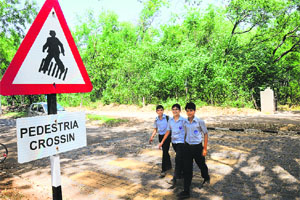|
Roadsafe
 Traffic
management has many dimensions. India has the dubious
distinction of having the highest number of road fatalities in the
world, about 150.000 killed each year. Of this, 12.500 are
pedestrians. The World Bank (WB), World Health Organisation (WHO) and
the (FIA) Foundation for the Automobile have come together to initiate
the Global Road Safety Partnership. A UN Global Road Safety Week was
held in Chandigarh recently. These agencies have spent the last six
years in preparing a Good Practice Manual (GPM) which emphasises the
use of seat belts (which we are reluctant to use), child seats (which
don't exists in this country and helmets (irrespective of religion).
Manuals and procedure guides are of no use. What is required is
discipline. Traffic
management has many dimensions. India has the dubious
distinction of having the highest number of road fatalities in the
world, about 150.000 killed each year. Of this, 12.500 are
pedestrians. The World Bank (WB), World Health Organisation (WHO) and
the (FIA) Foundation for the Automobile have come together to initiate
the Global Road Safety Partnership. A UN Global Road Safety Week was
held in Chandigarh recently. These agencies have spent the last six
years in preparing a Good Practice Manual (GPM) which emphasises the
use of seat belts (which we are reluctant to use), child seats (which
don't exists in this country and helmets (irrespective of religion).
Manuals and procedure guides are of no use. What is required is
discipline.
For example, tourist
cars and buses come to the Lake Club park across the road. After
sitting cooped up in their vehicles for hours, tourists, awed by the
beauty of the lake, and jay walk across the road, oblivious of
traffic. They are fair prey for motorists who do not respect road
rules like speed limits or zebra crossings. An underpass is required
but the proposal has been turned down many times. The Global Road
Safety Partnership has made valuable recommendations based on
observations collected from around the world over the past six years.
However, they must accept that what applies to and works in other
countries may not be practical in India.
 Chandigarh plays host as
capital to three states: The Union Territory, Punjab and Haryana.
Every other car has a red or blue light on the roof, giving them the
right to drive the way they want to, read this as the right not to
observe any road rules. The law makers are the law breakers. No
traffic policeman dare stop them, leave alone challan them.
Often these dome-light cars are driven by the security personnel or
the brats of the high and mighty. We do not have qualified road
engineers or traffic-management experts. Roads are built by PWD. Can
they build roads? Yes, but not safe roads. A road becomes congested
and while widening it, the footpath disappears because the focus is on
cars, not pedestrians. A high-speed expressway is built. It is for
cars only. We have not emerged fully from the bullock-cart stage. No
provisions for animal-drawn carts, hand-carts, cycles or pedestrians.
Cyclists and pedestrians account for the largest number of fatalities.
Think of them. Roads are not only for cars. There are other road users
and more vulnerable than motorists, the pedestrians. Walk safe! Chandigarh plays host as
capital to three states: The Union Territory, Punjab and Haryana.
Every other car has a red or blue light on the roof, giving them the
right to drive the way they want to, read this as the right not to
observe any road rules. The law makers are the law breakers. No
traffic policeman dare stop them, leave alone challan them.
Often these dome-light cars are driven by the security personnel or
the brats of the high and mighty. We do not have qualified road
engineers or traffic-management experts. Roads are built by PWD. Can
they build roads? Yes, but not safe roads. A road becomes congested
and while widening it, the footpath disappears because the focus is on
cars, not pedestrians. A high-speed expressway is built. It is for
cars only. We have not emerged fully from the bullock-cart stage. No
provisions for animal-drawn carts, hand-carts, cycles or pedestrians.
Cyclists and pedestrians account for the largest number of fatalities.
Think of them. Roads are not only for cars. There are other road users
and more vulnerable than motorists, the pedestrians. Walk safe!
|